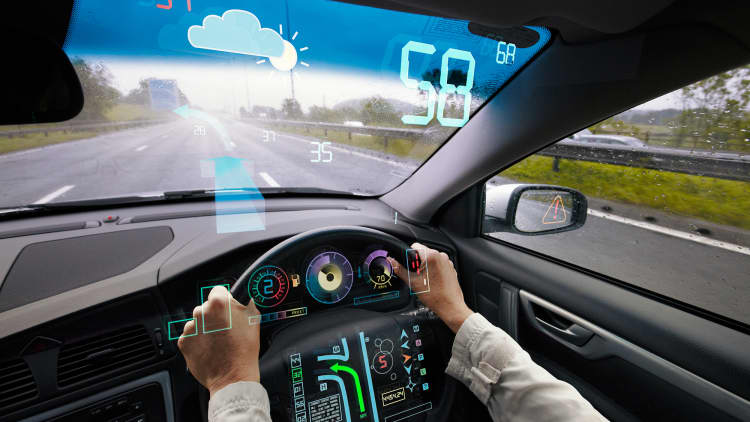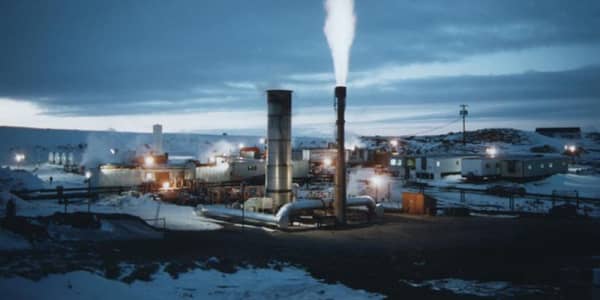To understand what transportation will look like in 2039, follow the big money.
Long-term investors who control tens of billions of dollars—private-equity firms, sovereign wealth funds, public pensions and the like—aren't betting on the proverbial jet pack of tomorrow. Instead, they hope to make substantial returns by focusing on more immediate—and boring—needs, like fixing bridges, redesigning airports and tweaking road and car technology.
Deals like Industry Funds Management's purchase of London Stansted Airport in 2013; Fortress Investment Group's ongoing development of Florida East Coast Industries, a regional rail system from Miami to Orlando; and Global Infrastructure Partners' recent sale of its stake in the Port of Brisbane to Canadian pension La Caisse de dépôt et placement du Québec show how private investors will have a big part in shaping the evolution of transportation over the next 25 years.
"History has shown that the public and broader market forces will look for the most efficient form of transportation available, and for the foreseeable future this probably means a reliance on current technologies using existing forms of infrastructure," said Dale Bonner, chairman of infrastructure developer Plenary Group USA.
"Current modes of surface, air and water transportation are likely to remain with us for the foreseeable future," added Bonner, the former California secretary of business, transportation and housing. "Most investors are betting on this also, since so much of the investment is in technologies designed to improve rather than replace these modes and the complex systems they rely upon."
Of course, many novel transportation technologies are in development. Sub-orbital flight, backed by Richard Branson, Jeff Bezos and others, could cut a 15-hour plane trip to two hours. Gas and electricity are likely to increasingly power cars and trucks, as Tesla has successfully pioneered. And driverless vehicles, like the prototypes that Google recently trotted out, are entering the realm of serious discussion.

Huge need
The need for contemporary transportation fixes is jarring.
McKinsey estimates that $57 trillion of infrastructure investment is needed by 2030 to support economic growth expectations. A big chunk, $23.8 trillion, is from transportation-related projects: roads ($16.6 trillion), rails ($4.5 trillion), seaports ($0.7 trillion) and airports ($2 trillion).
After all, the global population is expected to hit 9 billion by 2050, which could mean 3 to 4 times as much passenger travel and 2.5 to 3.5 times as much freight movement as in 2000, according to the International Transport Forum.
The situation in the U.S. is no different. As Fortress Investment Group has noted publicly, an estimated $3.6 trillion will be required to repair existing infrastructure in the U.S. Much of that represents roads ($1.73 trillion) plus airports ($135 billion) and rails ($100 million).
"Our current infrastructure deficit is an economic drag on businesses and consumers alike, and further investment is crucial to fostering economic growth, creating jobs and keeping us competitive in the global economy," BlackRock chairman and CEO Larry Fink said in July about a new White House initiative to fund American infrastructure rejuvenation with the help of private capital.
There's also tremendous opportunity in getting more out of existing transportation infrastructure.
A 2013 report by McKinsey estimated that the world could save $1 trillion a year from 2013 to 2030 by improving current infrastructure through better project selection, streamlined construction, and operational improvements of existing roads, seaports and other assets. All this would improve productivity by 60 percent.
"Getting the most out of existing assets is becoming a critical imperative as many forms of infrastructure hit capacity constraints that cannot be resolved simply by building more," McKinsey noted.
Big funds lined up
Investors are well aware of that need and their ability to step in where governments can't. Municipal bond issuance is down sharply since 2010, and federal and local governments often struggle to find funding for large infrastructure projects.
Benjamin Gordon, an industry expert and founder of mergers and acquisitions–focused BG Strategic Advisors, estimates that private-equity firms alone will invest at least $100 billion in the next five to seven years on transportation.
"Private equity will be vital to shaping transportation over the next 25 years," Gordon said.
Top 10 transport-only investment funds
| Fund Name | Fund Manager | Fund Size<br> ($m) | Target size <br>($m) | Final Close | Geographic<br> focus | Country<br> focus |
|---|---|---|---|---|---|---|
| GS Infrastructure Partners II | Goldman Sachs Principal Investment Area | 3,100.00 | 7,500.00 | 3/1/2010 | Global | N/A |
| J.P. Morgan Global Maritime Investment Fund | JP Morgan Asset Management | 780.33 | 750 | 6/1/2012 | Global | N/A |
| Airline Credit Opportunities II | Castlelake | 605.5 | 400 | 2/1/2011 | Global | N/A |
| Transportation Recovery Fund | WL Ross & Co. | 562 | 500 | 6/1/2014 | Global | N/A |
| Piramal Roads Infra | Ashok Piramal Group | 300 | 300 | 11/1/2011 | Asia-Pacific | India |
| China Resources Urban Car Park Investment Partnership | China Resources Capital | 265 | 265 | 2/1/2013 | Asia-Pacific | China |
| Brasil Portos e Ativos Logísticos FIP | BRZ Investimentos | 259.62 | 227.14 | 7/1/2012 | Latin America | Brazil |
| JPMorgan AIRRO India SideCar Fund | JP Morgan Asset Management | 230 | - | 5/1/2012 | Asia-Pacific | India |
| TIIC Fund | Transport Infrastructure Investment Company | 188.23 | 684.47 | 4/1/2010 | Global | N/A |
| SIDVC Wuzhong Infrastructure Industry fund | Suzhou International Development Venture Capital Holding Co., Ltd. (SIDVC) | 161.21 | 161.21 | 6/1/2013 | Asia-Pacific | China |
Source: Source: Research & Analytics division of PEI Media, Q2 2009 - Q2 2014
Top 10 infrastructure investment funds that include transportation
| Fund Name | Fund Manager | Fund Size<br> ($m) | Target size<br> ($m) | Final Close | Geographic focus |
|---|---|---|---|---|---|
| Global Infrastructure Partners II | Global Infrastructure Partners | 8,250.00 | 6,000.00 | 10/1/2012 | Global |
| Brookfield Infrastructure Fund II | Brookfield Asset Management | 7,000.00 | 5,000.00 | 10/1/2013 | Global |
| Alinda Infrastructure Fund II | Alinda Capital Partners | 4,100.00 | 5,000.00 | 1/1/2010 | Global |
| Macquarie European Infrastructure Fund 4 (MEIF 4) | Macquarie Group | 3,764.57 | 2,737.87 | 5/1/2013 | Pan-European |
| GS Infrastructure Partners II | Goldman Sachs Principal Investment Area | 3,100.00 | 7,500.00 | 3/1/2010 | Global |
| Brookfield Americas Infrastructure Fund | Brookfield Asset Management | 2,700.00 | 1,500.00 | 9/1/2010 | North America |
| EQT Infrastructure Fund II | EQT | 2,642.05 | 2,053.40 | 1/1/2013 | Global |
| Highstar Capital IV | Highstar Capital | 2,000.00 | 3,500.00 | 5/1/2012 | North America |
| CPG China Infrastructure Fund I | CPG Capital Partners | 2,000.00 | 2,000.00 | 11/1/2009 | Asia-Pacific |
| Gulf One Infrastructure Fund I | Gulf One | 2,000.00 | 2,000.00 | 2010 | Middle East/Africa |
Source: Source: Research & Analytics division of PEI Media, Q2 2009 - Q2 2014
Kathryn Leaf Wilmes, a partner at $28.8 billion private-equity-fund investor Pantheon, agreed.
"Private-sector capital will play an increasingly critical role in funding the transportation projects of the future. The public sector can't afford to shoulder the cost alone," Wilmes said.
"This is a steep bill for budget-constrained governments who will need to look to the private sector to help bridge the funding gap," she added. "The good news is that there is significant investor demand for high-quality transportation projects."
Read MorePrivate equity sees opportunity in all things that crumble
The number of investors who fund large transportation projects have proliferated over the last 10 years. Today, large banks and private-equity firms, such as Carlyle, JPMorgan, Morgan Stanley, KKR, Goldman Sachs and Citi, compete with large public pensions, like CalPERS, Ontario Teachers' Pension Plan and the Teacher Retirement System of Texas for the best deals.
"There currently exists a tremendous global opportunity to deploy private capital in partnership with traditional financiers," said Jim Barry, head of infrastructure at BlackRock. "Infrastructure debt and equity has seen significant growth in recent years as pension and insurance capital explores opportunities in lending for roads, rail and shipping facilities."
Top 10 institutional investors active in transportation infrastructure
| Investor | Type | Country | Funds under<br> Mgmt<br> (mn) | Funds under<br> Mgmt<br> (Curr) | Current Allocation<br> to Infrastructure<br> (%) |
|---|---|---|---|---|---|
| OMERS | Public Pension Fund | Canada | 65116 | CAD | 24.07 |
| National Pension Service | Public Pension Fund | South Korea | 436000000 | KRW | 2.6 |
| Corporación Andina de Fomento (CAF) | Government Agency | Venezuela | 26816 | USD | 42 |
| CPP Investment Board | Public Pension Fund | Canada | 219100 | CAD | 4.58 |
| APG - All Pensions Group | Asset Manager | Netherlands | 375000 | EUR | 2 |
| AustralianSuper | Superannuation Scheme | Australia | 75000 | AUD | 14 |
| Ontario Teachers' Pension Plan | Public Pension Fund | Canada | 140800 | CAD | 6.82 |
| QIC | Asset Manager | Australia | 77360 | AUD | 10.32 |
| Future Fund | Sovereign Wealth Fund | Australia | 97573 | AUD | 7.9 |
| CDP Capital - Private Equity Group | Asset Manager | Canada | 200100 | CAD | 3.39 |
| Asian Development Bank | Bank | Philippines | 163500 | USD | 3.82 |
Source: Source: Preqin
Not all private-capital appetite for transportation investing lines up perfectly with need.
"One of the challenges facing investment in transportation is that there is a mismatch between where the capital is most needed and where infrastructure investors are looking to invest," Pantheon's Wilmes said. "Most infrastructure investors are risk averse, which means they have a strong bias to invest in existing, operating assets as opposed to funding new development, which is a higher-risk opportunity."
The potential solution, according to Wilmes, is public-private partnerships, whereby governments combine with private funds to finance long-term projects. "Greater government support for greenfield projects ... will be critical to help unlock private-sector capital over the near term," she said.
Top 10 Transportation Deals, All Time
| Asset | Transaction<br> Date | Industry | Country | Total Deal<br> Size (mn) | Investors<br> (Firms) |
|---|---|---|---|---|---|
| Qatar Railways Development Company | 11/1/2009 | Railroads | Qatar | 17000.00 EUR | Deutsche Bahn, Qatar Investment Authority |
| Heathrow (BAA) | 6/1/2006 | Airports | UK | 10300.00 GBP | CDP Capital - Private Equity Group, Ferrovial, GIC |
| SEA High Speed Railway Line | 6/1/2011 | Railroads | France | 7800.00 EUR | Ardian, CDC Infrastructure, Meridiam Infrastructure, VINCI Concessions |
| ASF | 12/1/2005 | Toll Roads | France | 9100.00 EUR | VINCI Concessions |
| Itinere Infraestructuras | 12/1/2008 | Toll Roads | Spain | 7880.00 EUR | Bilbao Bizkaia Kutxa, Caixa Galicia, Caixanova, Cajastur, Citi Infrastructure Investors |
| Guarulhos International Airport | 2/1/2012 | Airports | Brazil | 16200.00 BRL | Construtora OAS, FUNCEF, PETROS, PREVI, Unidentified Investor/s |
| SANEF | 2/1/2006 | Toll Roads | France | 7791.00 EUR | Abertis, Ardian, CDC Infrastructure, CNP Assurances, Crédit Agricole Assurances-Prédica, FFP |
| Intercity Express Programme | 7/1/2012 | Rolling Stock | UK | 5800.00 GBP | Hitachi, John Laing |
| North West Rail Link | 6/1/2014 | Railroads | Australia | 8300.00 AUD | John Holland, Leighton Contractors Infrastructure, MTR Corporation, Plenary Group, UGL Limited |
| Angel Trains | 8/1/2008 | Rolling Stock | UK | 3600.00 GBP | Access Capital Advisers, Amber Infrastructure Group, AMP Capital Investors, Arcus Infrastructure Partners, Deutsche Bank |
Source: Source: Preqin
Driverless cars and spaceflights?
To be sure, some investments could mean big transportation changes by 2039.
One example is computer-driven cars and trucks. "The driverless vehicle technology that can complement and be integrated with existing technologies and systems seem most likely to catch on over the next couple of decades," said Bonner of Plenary.
"Automated autos and trucks are also a serious possibility within the next 25 years, assuming the liability issues can be dealt with," added Bob Poole, director of transportation policy at the Reason Foundation.
Read MoreTake the wheel please, I'm done driving
Another possibility is suborbital flight. "I see great potential for intercontinental suborbital flight services evolving from today's early efforts to provide suborbital tourist flights," Poole said. "Intercontinental ballistic flights have been a staple of science fiction since the 1950s, but they are a logical extension of today's emerging suborbital tourist flights."
A final example is new transportation fuel sources. "The structural implications of the fracking phenomenon means natural gas and its derivatives, like electricity and fuel cells, will make substantial inroads into transport over the next 25 years," BlackRock's Barry said.

While those novel systems are possible, transport appears more likely to be shaped by incremental improvements.
"What ever happened to the flying cars, the supersonic passenger jets and other technologies that have been talked about for many decades but never commercialized?" asked Bonner. "Many of the revolutionary technologies talked about today would require entirely new forms of infrastructure, systems and regulation. Although some angel investors, venture funds and private-equity investors are working on discrete elements of some of the new technologies, none can be shown to yield substantial cost, capacity or time benefits."
Read MoreFuture of flight: Changes coming in 2039
A 2014 report by the World Economic Forum and the Boston Consulting Group on transportation in 2025 focused on technology-driven improvements to current means of transportation, as opposed to entirely new technologies. Among the visions were electronic visas and identification for easy border crossings and security checks; dynamic traffic control by providing drivers with automated updates and alternate routes; and virtual logistics helpers to keep travelers and cargo on time.
"The solutions will allow us to revolutionize travel and transport," John Moavenzadeh, senior director of mobility industries at the World Economic Forum, said in releasing the report. "The tremendous benefits they can provide to public and private sector are clear. What is needed to realize those benefits is for the relevant stakeholders to come around the table to work together on bringing them to life."
Returns not always high
While infrastructure investing has big promise, it hasn't always been highly lucrative for investors. A group of 55 private-equity infrastructure funds tracked by online PE marketplace Palico going back to 1992 had an average net annual return of 4.7 percent as of the end of 2013 (the top quartile gained 9.8 percent).
By comparison, PE returns of all strategies averaged 13.9 percent net of fees from 2003 to 2013 and outperformed the S&P 500 with dividends by 6.5 percentage points, according to a recent report from industry trade association Private Equity Growth Capital Council.





